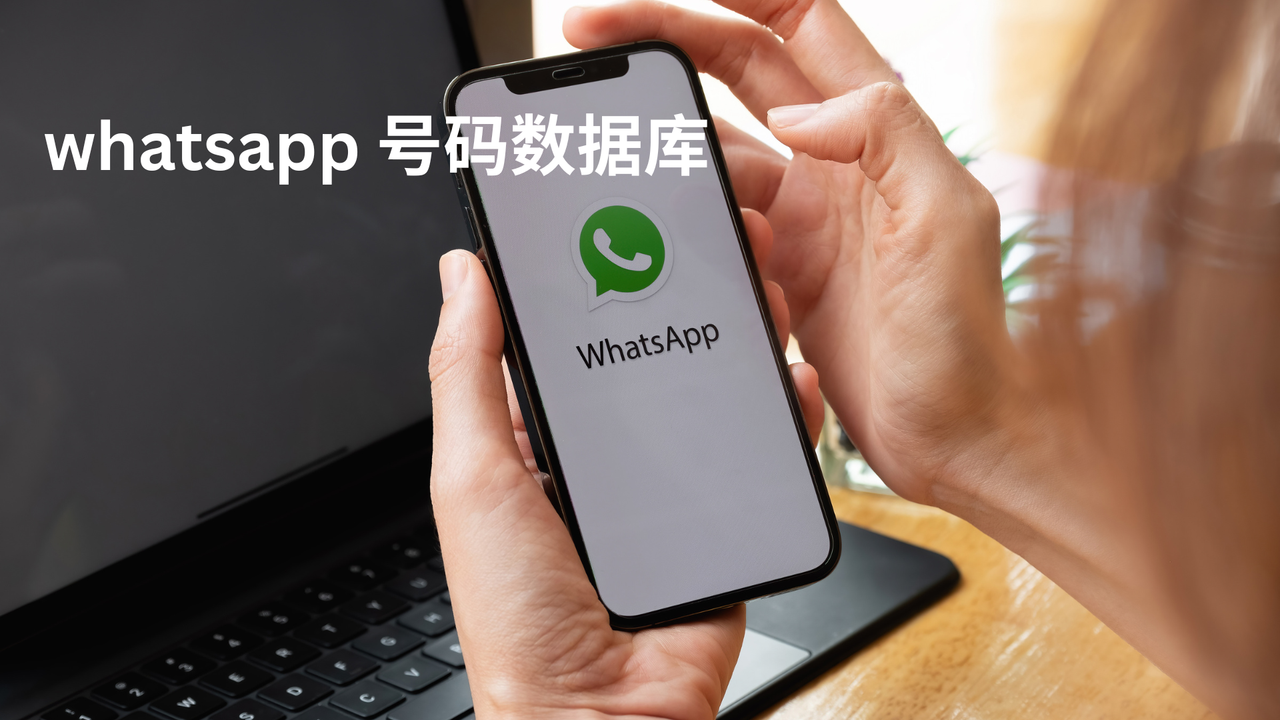WhatsApp 数据收集的技术概况
围绕“WhatsApp 号码数据库”创建的技术环境是多方面的,从良性的手动输入到复杂的、通常是非法的自动抓取技术,不一而足。最基本的,用户只需在手机中保存联系人即可构建自己的个人数据库,然后该数据库会自动与 WhatsApp 同步,从而允许他们与自己的网络进行通信。这是该平台的预期合法用途。然而,该术语通常意味着更广泛的含义,并且可能存在问题。获取大量 WhatsApp 号码的非法方法通常涉及从网站、社交媒体资料,甚至其他平台的受感染数据库中抓取公开信息。虽然 WhatsApp 本身拥有强大的安全 whatsapp 号码数据库 措施来防止直接抓取其用户群,但相关服务或用户习惯中的漏洞仍可能被利用。例如,一些与 WhatsApp 集成的第三方应用程序或 Web 服务,如果没有得到适当的保护,可能会无意中泄露用户数据。此外,一些个人或组织可能会从经纪人那里购买数据,而这些经纪人是通过可疑手段获取数据的,例如数据泄露或利用用户可能在其他在线平台上分享其 WhatsApp 号码的薄弱隐私设置。这些方法凸显了数据安全与试图利用数据安全的人之间持续不断的“军备竞赛”,强调用户需要对自己的数字足迹保持警惕,平台也需要不断加强保护措施。了解这些数据获取的技术途径对于理解大规模 WhatsApp 号码数据库的范围和潜在危险至关重要。人工智能和机器学习的发展也带来了新的挑战,因为这些技术可以用来更有效地识别和提取信息模式,从而可能导致此类数据库的汇编,这进一步加剧了日益互联世界中数据保护和隐私问题的复杂性。这些技术的复杂性通常意味着用户并不知道自己的数据正在被收集,这使得保护自己变得更加困难。
法律框架和数据隐私法规
管理“WhatsApp 号码数据库”收集、存储和使用的法律框架非常复杂,且在不同司法管辖区之间存在很大差异,但它们主要围绕数据隐私和同意原则。欧洲的《通用数据保护条例》(GDPR)、美国的《加州消费者隐私法案》(CCPA)以及其他国家的类似法律等主要法规旨在赋予个人对其个人数据的更多控制权。这些法律通常规定,未经个人明确知情同意,不得收集或处理个人数据(包括电话号码)。这意味着,仅仅公开电话号码并不意味着可以自动将其添加到商业或大众营销数据库中。此外,这些法规通常对数据安全、数据保留以及个人访问、更正或删除其数据的权利施加了严格的要求。未经用户直接知情同意,通过抓取或从第三方购买获取 WhatsApp 号码几乎总是违反这些法律规定。违反这些法规的公司或个人可能面临严厉的处罚,包括巨额罚款和声誉损害。挑战在于如何有效地执行这些法律,尤其是在数据收集和使用跨越国界的情况下。互联网的全球性意味着在一个国家收集的数据可能会在另一个国家使用,这使得管辖权和监管更加复杂。此外,技术的快速发展往往超过新法律框架的发展速度,从而产生了可被利用的灰色地带。因此,尽管存在着强有力的法律,但在实际应用中遏制非法WhatsApp号码数据库的泛滥仍然是一场持续的战斗,需要监管机构时刻保持警惕,并让公众更好地了解自己的数据权利。
群发信息和未经请求的联系的道德影响
除了法律后果之外,使用“WhatsApp 号码数据库”进行群发消息和未经请求的联系也引发了严重的伦理担忧。问题的核心在于侵犯隐私以及可能造成的骚扰和不便。当个人收到来自他们未同意互动的未知实体的消息时,这会侵犯他们的个人空间,并可能导致被侵犯和烦扰的感觉。对于像 WhatsApp 这样的平台来说尤其如此,因为它主要设计用于个人、一对一沟通或自选群组内的沟通。通过 WhatsApp 接收未经请求的促销信息、垃圾邮件,甚至网络钓鱼攻击,都会降低用户体验,并削弱用户对平台的信任。此外,将此类数据库用于政治竞选或高度精准的广告投放,可能会被操纵,因为它允许实体绕过传统的广告渠道,在未经用户明确邀请的情况下直接侵入个人的私人通信空间。这可能导致回音室效应、虚假信息的传播,以及一种持续被推销的感觉,即使在本应属于私人的领域也是如此。道德义务在于尊重个人自主权和知情同意,并认识到数据可以被收集并不意味着可以在未经适当许可和不考虑接收者福祉的情况下使用。大量未经请求的联系的长期后果可能包括用户疲劳、合法沟通互动的下降以及数字礼仪的普遍衰败,使真诚的联系在日益嘈杂的数字环境中更难蓬勃发展。

数据经纪业务及其阴暗面
“WhatsApp 号码数据库”经常与数据经纪的暗网相交织,这是一个利润丰厚的行业,通过收集、分析和出售个人信息来运营。虽然一些数据经纪商在合法的范围内运营,汇总公开信息或经用户同意共享的数据,但相当一部分市场交易的数据是通过不太谨慎的手段获取的。这种阴暗的一面涉及抓取数据、数据泄露信息或通过欺骗手段获取的数据的交易。WhatsApp 号码与其他人口统计或行为数据相结合,就成为营销人员、政治活动甚至诈骗分子的宝贵商品。这些经纪商通常声称他们的数据是“选择加入”或“合法来源”,但尽职调查往往会发现缺乏适当的同意或获取方式可疑。对于那些希望绕过传统广告成本并直接与潜在客户互动的企业来说,随时可用的“WhatsApp 号码数据库”对于定向推广具有强大的吸引力。然而,从未经核实的来源购买此类数据不仅会给买家带来重大的法律风险,还会助长不道德的生态系统,将个人隐私视为可以买卖的商品。数据经纪的不透明性使得个人难以追踪其数据的使用方式和使用者,这进一步削弱了人们对数字平台和更广泛的互联网的信任。对此类数据库的需求刺激了供应,形成了持续的数据利用循环,对数字时代的个人隐私和数据安全构成了重大威胁。
WhatsApp 的立场和应对滥用的措施
WhatsApp 作为一个平台,始终致力于保护用户隐私,并已实施多项措施打击其服务的滥用,包括创建和使用未经授权的“WhatsApp 号码数据库”。默认的端到端加密确保用户之间交换的消息安全无虞,即使是 WhatsApp 自身也无法拦截。此外,该平台还制定了强有力的政策,严防垃圾邮件、自动发送消息以及使用第三方工具进行群发。WhatsApp 积极运用机器学习和人工智能来检测和屏蔽从事可疑活动的账户,例如在短时间内向未知联系人发送大量消息。被发现违反服务条款的账户,包括与未经请求的群发消息相关的账户,通常会被封禁。该公司还为用户提供屏蔽和举报不良联系人的功能,为社区驱动的识别和减少垃圾邮件的努力做出了贡献。虽然这些措施意义重大,但 WhatsApp 庞大的用户群(数十亿用户)以及那些试图利用该平台的黑客的聪明才智,仍带来了持续的挑战。平台安全与恶意行为者之间的猫鼠游戏意味着新的漏洞或规避方法不断被探索。因此,尽管 WhatsApp 的立场明确且其应对措施也在不断发展,但用户也有责任保持警惕,谨慎保护个人信息,并报告任何可疑活动,以帮助维护平台的完整性,并保护其庞大用户群体的隐私,免受非法“WhatsApp 号码数据库”的负面影响。
对用户的影响:隐私侵犯和垃圾邮件超载
“WhatsApp 号码数据库”的泛滥对个人用户产生了直接且有害的影响,主要表现为隐私被侵犯以及大量不受欢迎的信息(通常称为垃圾邮件)的涌入。当用户的 WhatsApp 号码在未经其同意的情况下被纳入此类数据库时,他们将失去对联系人的控制,从而将个人沟通渠道变成潜在的垃圾邮件传播渠道。这种不相关甚至恶意内容的持续轰炸降低了他们的数字体验质量。隐私感(个人通讯的基本期望)受到损害,导致用户感到不断受到针对和监视。这可能导致用户对在线分享联系信息变得谨慎,即使是出于合法目的,也担心数据被收集。此外,大量的垃圾邮件使用户难以区分合法重要的信息和垃圾邮件,导致错过通讯或增加成为网络钓鱼诈骗和其他欺诈活动受害者的风险。屏蔽不受欢迎的号码和举报垃圾邮件所需的时间和精力也可能非常大,这加剧了用户的沮丧情绪。本质上,这些数据库的存在和使用将 WhatsApp 从一个私密、便捷的通讯工具变成了一个烦恼和潜在安全风险的来源,从根本上改变了用户与平台的关系,并削弱了对整个数字生态系统的信任。
保护自己免受不受欢迎的人的影响
鉴于网络信息的广泛可及性,以及您的“WhatsApp 号码数据库”可能在未经您明确同意的情况下被收集,主动采取措施保护您的隐私至关重要。首要的一步是,务必谨慎选择在线分享电话号码的渠道。避免在社交媒体个人资料、论坛或未加密的网站上公开发布。注册服务时,请考虑是否绝对有必要提供您的主要电话号码,如果不是,请探索其他联系方式或考虑使用备用号码。定期检查您的社交媒体帐户和其他在线平台上的隐私设置,确保您的联系信息不公开。警惕要求您提供个人信息的可疑链接或消息,因为这些可能是旨在窃取您数据的网络钓鱼攻击。建议您使用 WhatsApp 本身提供的隐私功能,例如控制哪些人可以查看您的“上次上线”信息、个人资料照片和“关于”信息。定期检查您已屏蔽的联系人,并将任何未经请求的消息或可疑活动直接报告给 WhatsApp。教育也是一个强大的工具;了解数据的收集和使用方式,可以帮助您对自己的数字足迹做出更明智的决策。通过采取这些措施,个人可以显著降低其 WhatsApp 号码被纳入不必要数据库的可能性,并降低在日益互联的数字世界中与未经请求的联系和隐私泄露相关的风险,从而确保在平台上获得更安全、更私密的沟通体验。
互联世界中数据隐私的未来
“WhatsApp 号码数据库”的概念,是数据隐私在日益互联的世界中面临的更广泛挑战的一个缩影。随着技术的进步,个人信息被收集、分析和传播的便利性不断提升,这给现有的法律和道德框架带来了巨大的压力。数据隐私的未来很可能伴随着法规的不断演变,并将更加强调个人控制、透明度以及数据保管人的问责制。对赋能用户更有效地管理数据的技术的需求将日益增长,例如去中心化身份解决方案和隐私保护数据分析。然而,个人也有责任提高数字素养,并积极管理自己的在线状态。打击非法数据收集和未经授权数据库扩散的斗争是一场持续的战斗,需要政府、科技公司和用户自身的共同努力。围绕“WhatsApp 号码数据库”的讨论凸显了就数据伦理进行全球对话的迫切需要,以确保技术进步与尊重个人权利和隐私之间的平衡。最终目标是创建一个数字环境,在不损害基本隐私权的情况下,充分发挥互联互通的优势,为每个人创造更安全、更可靠的在线体验铺平道路。人工智能的不断发展及其分析海量数据集的潜力进一步凸显了这些讨论的紧迫性,因为它为数据保护的挑战以及将个人信息汇编到易于访问的数据库中的影响带来了新的维度。